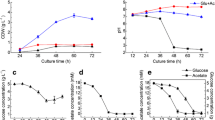Abstract
Chlorella vulgaris was grown photosynthetically in batch culture under nitrogen sufficiency or nitrogen limitation. The starch content of the cells was measured as the amount of glucose released by enzymic hydrolysis of partially purified starch. Nitrogen sufficient algae contained approximately 20% of their dry weight as starch, whereas in nitrogen limited cells starch comprised up to 55% of the cellular dry weight. Starch production was pH dependent; optimal production of starch was achieved between pH 7.5 and 8.0. Optimal growth of C. vulgaris occurred at pH 7.0. Carbon yield experiments showed that for every gram of carbon consumed 0.5 g of starch (glucose) could be recovered.
Similar content being viewed by others
References
Arad, S (1988). Production of sulfated polysaccharides from red unicellular algae. In: Stadler T, Mollion J, Verdus M-C, Karamanos Y, Morvan H, Christaen D (eds), Algal Biotechnology. Elsevier, Amsterdam, 65–87.
Barclay W, Wyman C, Lewin R A, Cheng L (1988). Development of microalgal systems for the production of liquid fuels. In: Stadler T, Mollion J, Verdus M-C, Karamanos Y, Morvan H, Christaen D (eds), Algal Biotechnology. Elsevier, Amsterdam, 55–64.
Becker E W, Venkatamaran L V, Khanum P M, (1976). Effect of different methods of processing on the protein efficiency ratio of the green alga Scenedesmus acutus. Nutrition Reports International 14: 305–314.
Ben Amotz A, Avron M (1983). Accumulation of metabolites by halotolerant algae and its industrial potential. Ann. Rev. Microbiol. 27: 95–119.
Benemann J R, Tillet D M, Weissman J C (1987). Microalgae biotechnology. Trends in biotechnology 5: 47–53.
Bhattacharjee J K (1970). Microorganisms as potential sources of food. Adv. Appl. Microbiol. 13: 139–150.
Borowitzka M A (1988). Vitamins and fine chemicals from micro-algae. In: Borowitzka M A, Borowitzka L J (eds), Micro-algal Biotechnology. Cambridge U.P., Cambridge, 153–196.
Bourges H, Sotomayor A, Mendoza E, Chavez A (1971). Utilization of the alga Spirulina as a protein source. Nutrition Reports International, 4: 31–43.
Cox J C, Kyle D J, Radmer R J, Delente J J (1988). Stable isotope labelled biochemicals from microalgae. Trends in Biotechnology 6: 279–283.
Dodd J C (1986). Elements of pond design and construction. In: Richmond A (ed.), Handbook of Microalgal Mass Culture. CRC Press, Boca Raton, FL, 265–284.
Gudin C, Thepenier C (1986). Bioconversion of solar energy into organic chemicals by microalgae. Adv. biotechnol. Processes 6: 73–110.
Myklestad S (1974). Production of carbohydrates by marine planktonic diatoms. I. Comparison of nine different species in culture, J. exp. mar. Biol. Ecol. 15: 261–274.
Oswald W J (1988). Large-scale algal culture systems. In: Borowitzka M A, Borowitzka L J (eds.), Micro-algal Biotechnology. Cambridge U.P., Cambridge, 357–394.
Pirt M W, Pirt S J (1977). Photosynthetic production of biomass and starch by Chlorella in chemostat culture. J. appl. Chem. Biotechnol. 27: 643–650.
Radmer R J, Behrens P W, Arnett K (1987). Analysis of the productivity of a continuous algal culture system. Biotech. Bioeng. 29: 488–492.
Renn D W (1988). Algal polysaccharides and their application in biotechnology, food and other items of commerce. In: Ramus J, Jones M C (eds.) Polysaccharides from Microalgae: a new agroindustry. Proc. Intl. Workshop. Duke University Marine Laboratory, Beaufort, North Carolina, 42–50.
Richmond A (1986). Outdoor mass cultures of microalgae. In: Richmond A (ed), Handbook of Microalgal Mass Culture. CRC Press, Boca Raton, FL, 285–330.
Richmond A, Becker E W (1986). Technological aspects of mass cultivation — a general outline. In: Richmond A (ed), Handbook of Microalgal Mass Culture. CRC Press, Boca Raton, FL, 245–264.
Author information
Authors and Affiliations
Additional information
author for correspondence
Rights and permissions
About this article
Cite this article
Behrens, P.W., Bingham, S.E., Hoeksema, S.D. et al. Studies on the incorporation of CO2 into starch by Chlorella vulgaris . J Appl Phycol 1, 123–130 (1989). https://doi.org/10.1007/BF00003874
Accepted:
Issue Date:
DOI: https://doi.org/10.1007/BF00003874




